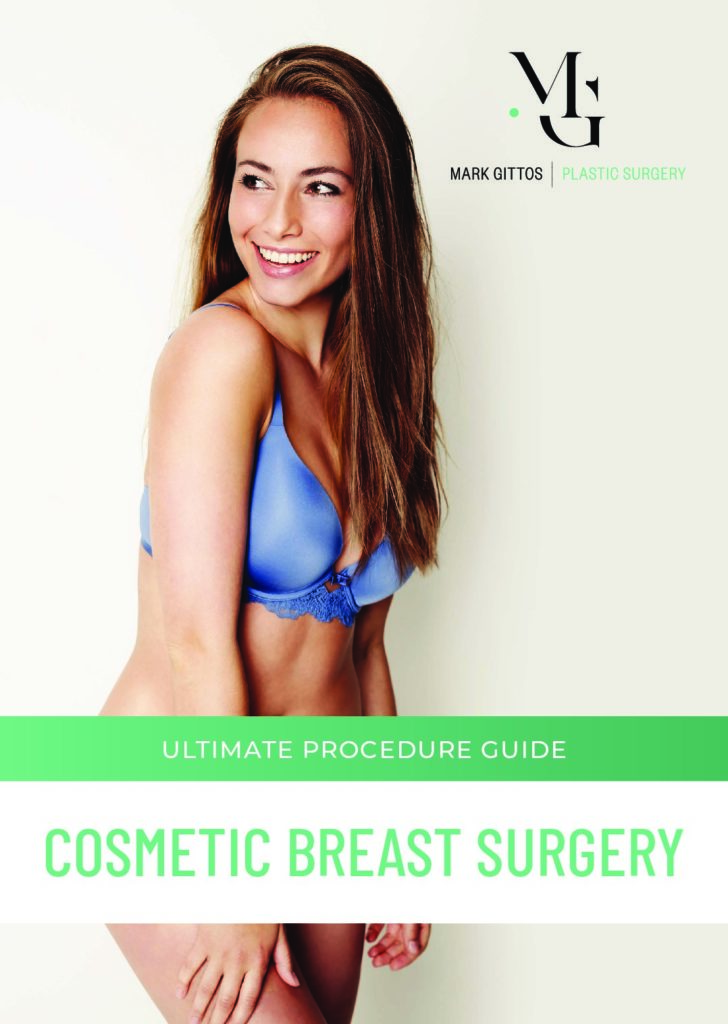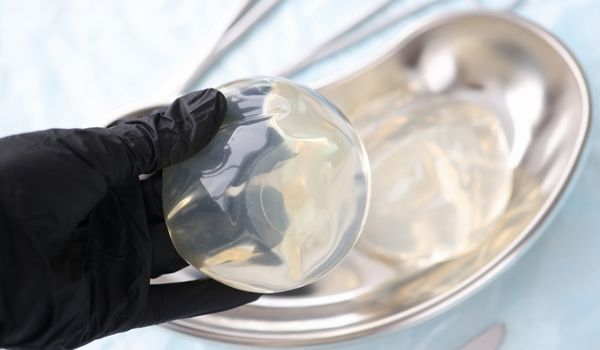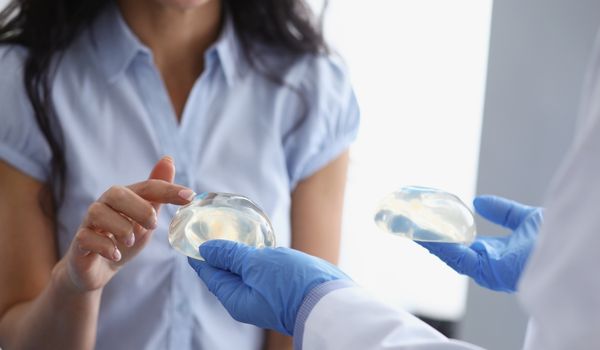Similarities and Differences Between Silicone and Saline Breast Implants
If you are considering getting a breast augmentation you should know that you can choose between silicone and saline breast implants. While both of them can be recommended for certain patients, they are different in many aspects.
Dr Mark Gittos is one of the top plastic surgeons in UK for breast surgery. He is highly experienced and has performed hundreds of breast procedures. Mr Gittos can guide you towards the best choice in terms of silicone vs saline breast implants that can give you the most natural and long-lasting results.
Download Mr Mark Gittos’ Guide to Cosmetic Breast Surgery

Saline Implants
These implants have been used for breast augmentation surgery for many years. They have a silicone outer shell that is empty and it is filled with sterile salt water during the surgery. This essentially means that the incision created to insert the implant can be much smaller and less noticeable. Saline implants also cost less than silicone implants.
One major drawback of the saline implant is that they are more visible underneath the skin which can cause a rippling effect. Certain people might feel that saline implants are firmer than the natural tissue of the breast or dislike the ‘water hammer’ effect.
Silicone Implants
Silicone implants are made up of a silicone gel which is a synthetic material. They feel quite similar to natural breasts. The silicone implants have an outer shell that is made of silicone and the inside is also filled with silicone gel. These implants come in many different types, sizes, and shapes. Mr Gittos can help you choose the right one based on your body’s anatomy and aesthetic goals.
Most people feel that silicone implants are more natural when it comes to feeling and touch. However, they have a higher risk of implant rupture. It is recommended to get regular MRI scans to check for any potential ruptures.
Breast Implants over the Years
Here’s a bit of history! Silicone gel implants were first used in 1960 and we have seen a lot of different variations ever since. Experts are continually trying to improve the product to offer the best results. Saline implants became popular in the 1990s and early 2000s. Significant advances have been made since then. Implants used today are the 7th and 8th generation of implants. The newest version has a 96% fill while the previous generation of implants had an 85% fill. Modern-day implants are also way more cohesive.
Which One is Safer- Silicone or Saline Breast Implant
Both saline and silicone implants are considered safe if you choose a highly experienced surgeon. There is a small percentage of people who experience BII or breast implant illness. It includes many medical problems ranging from fatigue, chronic headaches, aches, brain fog, and gastrointestinal symptoms. While there isn’t any direct evidence that shows implants cause BII, patients report improvement in health once they get rid of their implants.
To ensure safety, it is recommended to get your implants replaced every 10 years and get regular scans.
Implant Rupture: Saline Vs Silicone

Please note that both saline and silicone implants carry a risk of rupture. If you suspect an implant rupture, look out for these:
Saline
- With saline implants, the rupture can be spotted immediately as the breast/breasts will appear deflated
- Saline from the implant is sterile and will get reabsorbed into your body
- Surgery is needed to remove the deflated shell and replace it with a new implant (if that is what you desire)
Silicone
- Ruptures in silicone implants are very hard to detect because the silicone often gets trapped in fibrous capsule tissue
- A leak in the silicone implant is called a silent rupture which can sometimes lead to a change in breast size and hardness
- Silicone leakage can lead to breast pain and changes in breast shape as well
- You will get surgery to get rid of the ruptured implant. The surgeon can insert a new implant if required.
Similarities between Silicone and Saline Breast Implants
They essentially help you achieve the same goal. So, there has to be a common ground between the two. Let’s explore it:
· FDA Approved
Both silicone and saline implants are approved by FDA. So, you can get either of them without worry.
· Customisable Nature
Surgeons can customise breast implant surgery in different ways to fit your needs and goals. It includes size, profile, and placement.
· Durability
Both implants have an outer shell made up of silicone and are designed to last for 10 to 15 years. This time varies from person to person. Hence, it is recommended to get them checked or replaced every 10 years.
Key Differences between Silicone and Saline

Let’s explore the differences between silicone and saline implants:
· Fill Material
While both implants have the same outer shell, saline implants are filled with salt water while silicone ones contain a silicone gel.
· Age Guidelines
Saline implants are approved by FDA to be used on patients who are 18 years and older. On the other hand, silicone implants are approved by FDA to be used by people who are 22 years and older. Both of them could be used at any age, provided that the patient is going for breast reconstruction surgery.
· Rupture Risks
Rupture with saline implants is quite obvious as your breast will look instantly deflated as the saline water gets absorbed by your body. Spotting ruptures with silicone implants is quite tough as it isn’t apparent.
· Look & Feel
Silicone implants feel and look very similar to natural breast tissue. Saline implants do carry a risk of a rippling effect in some cases. Silicone implants might look more natural than saline implants.
· Cost
Saline implants are cheaper than silicone implants. This will reflect in the overall quote of the surgery.
· Incision Size
With saline implants, the incision is smaller as they are inflated after insertion. Silicone implants are prefilled and require a relatively longer incision.
Cost Comparison: Silicone Vs Saline Breast Implants
Breast implants surgery is an elective cosmetic surgery procedure (in most cases) which means it isn’t covered by insurance. One needs to keep in mind that implants aren’t meant to last a lifetime. And you have to get them replaced every 8 to 10 years.
Silicone implants can cost much more than saline implants. While creating the budget for the surgery, include the cost of follow-up MRIs and other recommended check-ups to everything is ok with the implants. Nearly 20% of people get their implants replaced or removed after 10 years because of aesthetic goals or implant ruptures. The surgery won’t be covered by insurance.
Always Explore Your Options

It is crucial to find a very reputable plastic surgeon to do your breast augmentation surgery. Invest enough time and energy into this step as your results depend on this, as well as your well-being during and after the procedure. During your consultation, it is always a good idea to look at before and after pictures. You and your surgeon can work together to choose an implant type that will suit your aesthetic goals.
Factors to Consider Before Getting Breast Implants
If you are thinking about getting implants, it is important to do your research on the subject. They do much more than change your appearance. Please keep in mind the following:
Breast implants will not prevent the sagging of breasts that is bound to happen with age. In order to correct the sagging of breasts, you will need breast lift surgery instead of augmentation. If you wish to increase the size of your breasts and lift them up, a combination of lift and augmentation will do the job.
The results of a breast implant surgery aren’t guaranteed to last for a lifetime. You are supposed to get them checked or replaced every 10 years otherwise you will put yourself at risk of implant rupture. Your breasts will continue to change with age after breast augmentation surgery. Factors like gravity, weight gain and weight loss will impact how your implants will look like. Any of these problems could lead to revision surgery.
Breast surgery can make mammograms quite complicated depending on the placement. While getting a mammogram, always tell your radiologist that you have implants. FDA recommends getting routine ultrasounds and MRIs after every 5 to 6 years to ensure there aren’t any complications. This is always recommended to patients. However, recent studies show a very different side. As per recent studies, routine screenings aren’t required unless you are suspecting an implant rupture or experiencing symptoms of BII – Breast Implant Illness.
Insurance doesn’t pay for the breast augmentation surgery unless it is done for medically necessary reasons such a reconstruction surgery post mastectomy. If you are getting it done due to cosmetic reasons, you will have to pay the cost from your pocket.
If you decide to get the implants removed, you might need a breast lift to make your breasts look better.
Saline Vs Silicone: What’s the Bottom Line?
Both saline and silicone implants are considered safe options. Both of them carry the potential of rupture. In case of a rupture, surgery will be needed for implant removal or replacement.
Silicone implants feel and look more natural than saline ones. With saline implants, the incision is generally smaller. Based on the anatomy of your body, your body type, and many other factors, your surgeon will recommend silicone or saline implants to create the best results.
Further Reading and Medical References about Silicone vs Saline Breast Implants
- Breast implants: Saline vs. silicone – Mayo Clinic
- Silicone vs saline breast implants – ASPS
- Prospective Study of Saline versus Silicone Gel Implants for Subpectoral Breast Augmentation
- Breast Augmentation – StatPearls – NCBI Bookshelf
- What you need to know about breast augmentation
Finding a Breast Augmentation Surgeon in United Kingdom
For many women in United Kingdom, having breast augmentation is a life-changing experience. There are many qualified doctors, but it is always best to find one who is experienced in breast augmentation procedures. Breast implants come in many different shapes and sizes, and there are various insertion techniques, so find a reputable practitioner who can give good advice on the right implants for you. Before considering breast implants, it is wise to find a surgeon who is also up to speed with new non-invasive techniques for breast enlargements, so you can investigate all the options before deciding on permanent surgical implants. Please avoid choosing a cheaper overseas option that lacks the ongoing support that a United Kingdom surgeon provides.
Always look for an experienced surgeon that you feel comfortable with and get a second opinion. If you’re still indecisive about the procedure, feel free to get in touch with our team.
You can contact us using this form to arrange to book a consultation with our Specialist Plastic Surgeon or to speak with our Patient Care Advisor.
Send an enquiry form today or phone 07 55785856 during Clinic Hours
About Mr Mark Gittos FRACS (Plast) – London Plastic Surgeons
Practice locations in London & Essex, UK and Auckland, New Zealand.
Mr Mark Gittos offers high quality, natural-looking cosmetic surgery results and is highly experienced in Breast, Body and Face Surgery having performed over 4000 Surgeries in the last 26 years.
With world-wide expertise Mr Gittos is an expert in breast, face and body surgery for men & women.
Mr Mark Gittos is a leading Specialist Plastic Surgeon and operates a practice in London UK and Auckland New Zealand. His practice focuses on both surgical and non-surgical procedures, each designed to help restore, improve or change a physical characteristic or problem. The first step in every case is to talk through your personal requirements and explore all the options, before deciding on the most effective solution.
Naturally, before any treatment is begun, we will explain clearly the advantages and risk factors; so that you have the information you need to make an informed decision that is best for you. Visit the practice to find out more.

NEXT STEPS
Do your Research
- Read the Website and Blogs relevant to your procedure
- Browse our Frequently Asked Questions including how to choose a Surgeon for your procedure
- Download the Guides to Surgery
What to Bring to your Plastic Surgeon Consultation
- Bring a friend or relative to help discuss the information and your choices
- Take lots of notes and read the documents provided thoroughly
- Want more information before scheduling your consultation?
Book your Initial Surgery Consultation
- A Referral from your GP or specialist is helpful but NOT essential – you can have a consultation without a GP Referral
- Email us or Call in London on 07557 858156 to arrange your surgeon consultation appointment.
- Book a consultation with Mr Gittos by paying the Consultation Fee
Please contact us to arrange to book a consultation with our Specialist Plastic Surgeon or to speak with our Patient Care Advisor.
Send an enquiry form today or UK phone 07557 858156 during Clinic Hours
